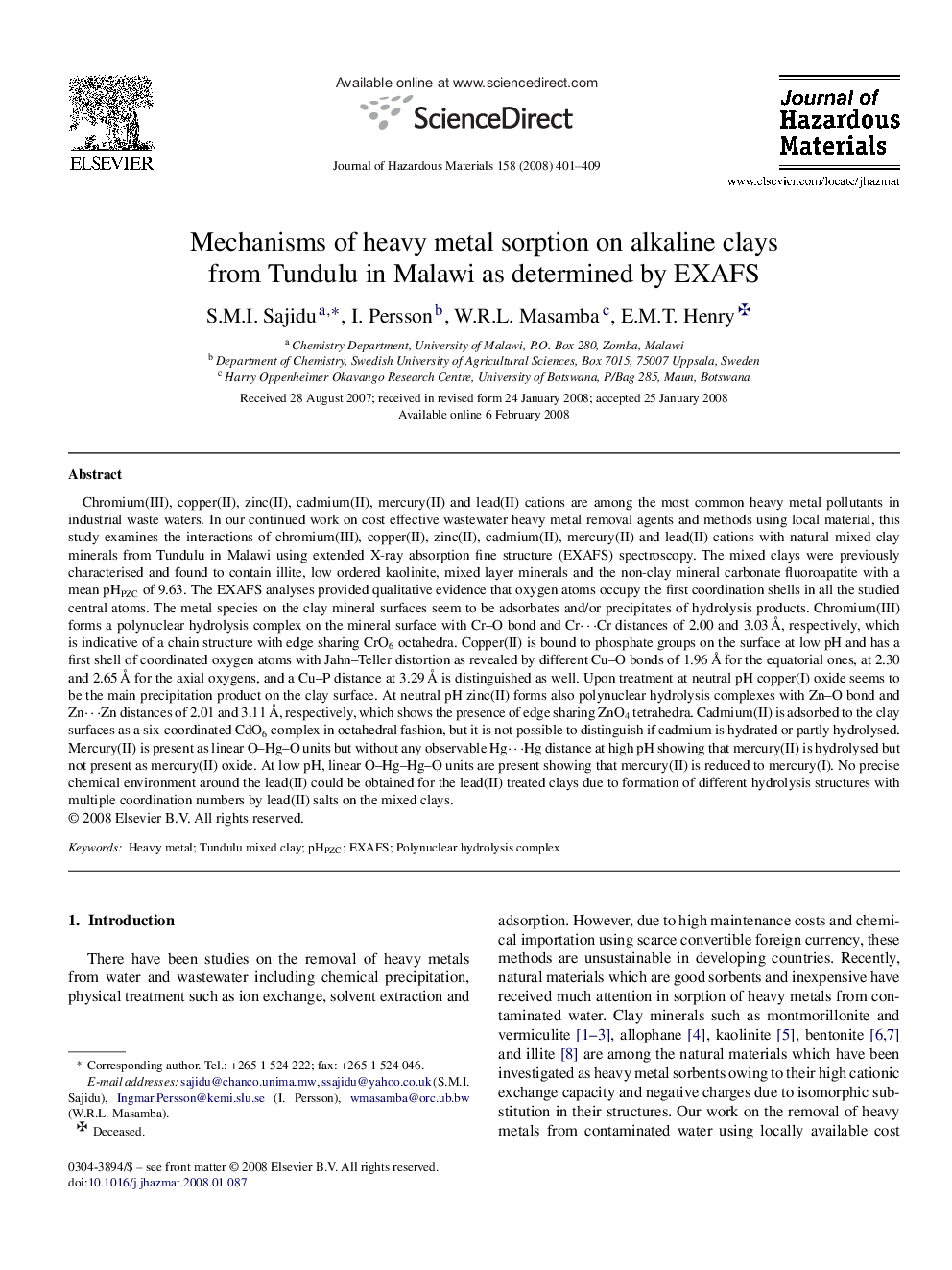| کد مقاله | کد نشریه | سال انتشار | مقاله انگلیسی | نسخه تمام متن |
|---|---|---|---|---|
| 583303 | 1453170 | 2008 | 9 صفحه PDF | دانلود رایگان |
عنوان انگلیسی مقاله ISI
Mechanisms of heavy metal sorption on alkaline clays from Tundulu in Malawi as determined by EXAFS
دانلود مقاله + سفارش ترجمه
دانلود مقاله ISI انگلیسی
رایگان برای ایرانیان
کلمات کلیدی
موضوعات مرتبط
مهندسی و علوم پایه
مهندسی شیمی
بهداشت و امنیت شیمی
پیش نمایش صفحه اول مقاله

چکیده انگلیسی
Chromium(III), copper(II), zinc(II), cadmium(II), mercury(II) and lead(II) cations are among the most common heavy metal pollutants in industrial waste waters. In our continued work on cost effective wastewater heavy metal removal agents and methods using local material, this study examines the interactions of chromium(III), copper(II), zinc(II), cadmium(II), mercury(II) and lead(II) cations with natural mixed clay minerals from Tundulu in Malawi using extended X-ray absorption fine structure (EXAFS) spectroscopy. The mixed clays were previously characterised and found to contain illite, low ordered kaolinite, mixed layer minerals and the non-clay mineral carbonate fluoroapatite with a mean pHPZC of 9.63. The EXAFS analyses provided qualitative evidence that oxygen atoms occupy the first coordination shells in all the studied central atoms. The metal species on the clay mineral surfaces seem to be adsorbates and/or precipitates of hydrolysis products. Chromium(III) forms a polynuclear hydrolysis complex on the mineral surface with Cr-O bond and Crâ¯Cr distances of 2.00 and 3.03 Ã
, respectively, which is indicative of a chain structure with edge sharing CrO6 octahedra. Copper(II) is bound to phosphate groups on the surface at low pH and has a first shell of coordinated oxygen atoms with Jahn-Teller distortion as revealed by different Cu-O bonds of 1.96Â Ã
for the equatorial ones, at 2.30 and 2.65Â Ã
for the axial oxygens, and a Cu-P distance at 3.29Â Ã
is distinguished as well. Upon treatment at neutral pH copper(I) oxide seems to be the main precipitation product on the clay surface. At neutral pH zinc(II) forms also polynuclear hydrolysis complexes with Zn-O bond and Znâ¯Zn distances of 2.01 and 3.11 Ã
, respectively, which shows the presence of edge sharing ZnO4 tetrahedra. Cadmium(II) is adsorbed to the clay surfaces as a six-coordinated CdO6 complex in octahedral fashion, but it is not possible to distinguish if cadmium is hydrated or partly hydrolysed. Mercury(II) is present as linear O-Hg-O units but without any observable Hgâ¯Hg distance at high pH showing that mercury(II) is hydrolysed but not present as mercury(II) oxide. At low pH, linear O-Hg-Hg-O units are present showing that mercury(II) is reduced to mercury(I). No precise chemical environment around the lead(II) could be obtained for the lead(II) treated clays due to formation of different hydrolysis structures with multiple coordination numbers by lead(II) salts on the mixed clays.
ناشر
Database: Elsevier - ScienceDirect (ساینس دایرکت)
Journal: Journal of Hazardous Materials - Volume 158, Issues 2â3, 30 October 2008, Pages 401-409
Journal: Journal of Hazardous Materials - Volume 158, Issues 2â3, 30 October 2008, Pages 401-409
نویسندگان
S.M.I. Sajidu, I. Persson, W.R.L. Masamba, E.M.T. Henry,